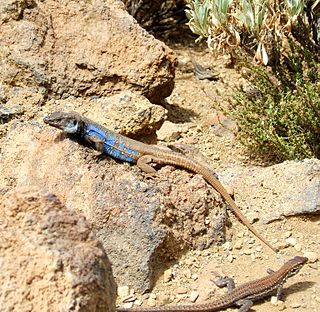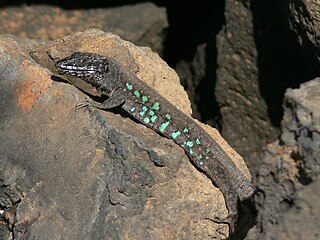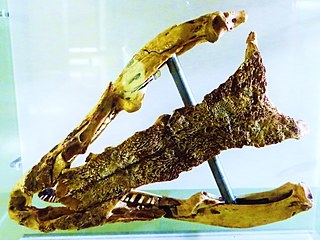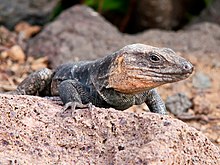
The genus Gallotia are the lacertids of the Canary Islands. This genus consists of a group that has been evolving there ever since the first islands emerged from the sea over 20 million years ago. The endemic species and subspecies of this group have a number of characteristics that make them quite special within their family (Lacertidae); their only close relatives are the sandrunner lizards (Psammodromus) of the western Mediterranean region. Gallotia are characteristic for eating significant quantities of plants, and several lineages are often presented as classic examples for insular gigantism. However, a find of an even larger Gallotia species from the early Miocene of mainland Europe casts doubt on this assumption. Instead the ancestor of all modern Gallotia species of the Canary islands was probably already very large but carnivorous.

The La Gomera giant lizard is a lacertid species that can be found on the island of La Gomera, one of the Canary Islands.

The El Hierro giant lizard is the only extant, critically endangered subspecies of Simony's giant lizard. It is endemic to El Hierro, the westernmost of the Canary Islands, where it is an official symbol.
The La Palma giant lizard is a large wall lizard endemic to the island of La Palma in the Canary Islands, currently extinct or critically endangered.

Simony's giant lizard is a large species of wall lizard endemic to the island of El Hierro and nearby islet Roque Chico de Salmor in the Canary Islands.

The Roque Chico de Salmor giant lizard is the extinct nominate subspecies of Simony's giant lizard, which was endemic to the small islet Roque Chico de Salmor northwest of El Hierro, the westernmost of the Canary Islands.

The Tenerife speckled lizard is a recently discovered lacertid endemic to Tenerife in the Canary Islands. It is the smallest member of the clade containing the western islands' giant species.

Boettger's lizard is a species of wall lizard in the family Lacertidae. The species is endemic to the Canary Islands. There are two recognized subspecies.

Gallotia galloti, also known commonly as Gallot's lizard, the Tenerife lizard, and the Western Canaries lizard, is a species of wall lizard in the genus Gallotia. The species is native to the Canary Islands of Tenerife and La Palma. Unlike most larger species of its genus, G. galloti is a commonly found animal. There are four recognized subspecies.

The Gran Canaria skink is a species of skink in the family Scincidae which is endemic to Gran Canaria. Its natural habitats are temperate forests, temperate shrubland, Mediterranean-type shrubby vegetation, temperate grassland, rocky areas, sandy shores, pastureland, and plantations. The adults measure 16 – 18 cm out of which the tail forms 50%. Their legs are tiny, slim, and have five fingers. They live solitarily and only seek a partner during the mating season. They are ovoviviparous; females give birth to 2 - 4 babies after three months of pregnancy. They are kept as pets in vivariums.

The Fuerteventura skink is an endangered ovoviviparous species of skink in the family Scincidae. Skinks are generally characterized by their smaller legs and less pronounced necks compared to typical lizards.

The West Canary skink, also known commonly as the Canaryan cylindrical skink, East Canary Islands skink, the Tenerife skink, is a species of lizard in the family Scincidae. The species is endemic to the Canary Islands.

The East Canary gecko or Canary wall gecko is a species of lizard in the family Phyllodactylidae. It is endemic to the eastern Canary Islands. Its natural habitats are temperate shrubland, Mediterranean-type shrubby vegetation, rocky areas, rocky shores, sandy shores, intertidal marshes, arable land, pastureland, plantations, rural gardens, and urban areas.

Boettger's wall gecko, also commonly known as the Gran Canaria gecko, is a species of lizard in the family Phyllodactylidae. The species is native to the Canary Islands and the Savage Islands. There are three recognized subspecies.

The Tenerife gecko, also known commonly as Delalande's gecko and the Tenerife wall gecko, is a species of lizard in the family Phyllodactylidae.

The Gomero wall gecko or La Gomera gecko, also known as perenquén in the Canary Islands, is a species of lizard in the family Phyllodactylidae. It is endemic to La Gomera.

The Atlantic lizard is a species of lizards in the family Lacertidae. It is endemic to the eastern Canary Islands Lanzarote and Fuerteventura and the smaller islands surrounding them.

Gallotia goliath is an extinct giant lizard species from the island of Tenerife of the Canary Islands, Spain. This reptile lived before the arrival of humans and is believed to have grown to at least 0.9 metres (3.0 ft) long. It was described by the German herpetologist Robert Mertens. Fossils of this lizard have been found in volcanic caves, where they often appear with those of other animals, like the Tenerife giant rat.

The Guayadeque ravine, in Spanish Barranco de Guayadeque, is a ravine-type valley located on the Spanish municipalities of Ingenio and Agüimes, in the province of Las Palmas on Grand Canary island, off the coast of Morocco.




















